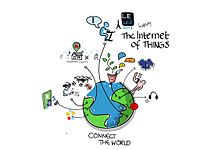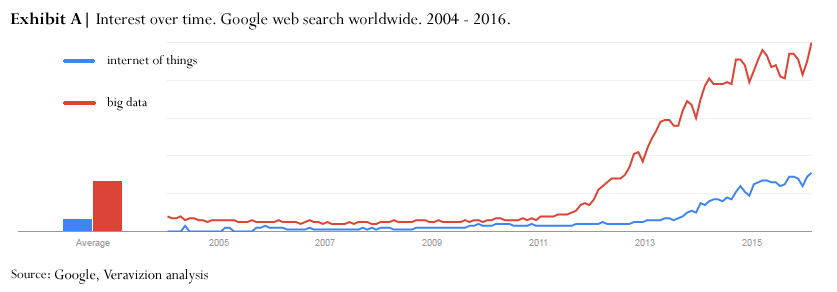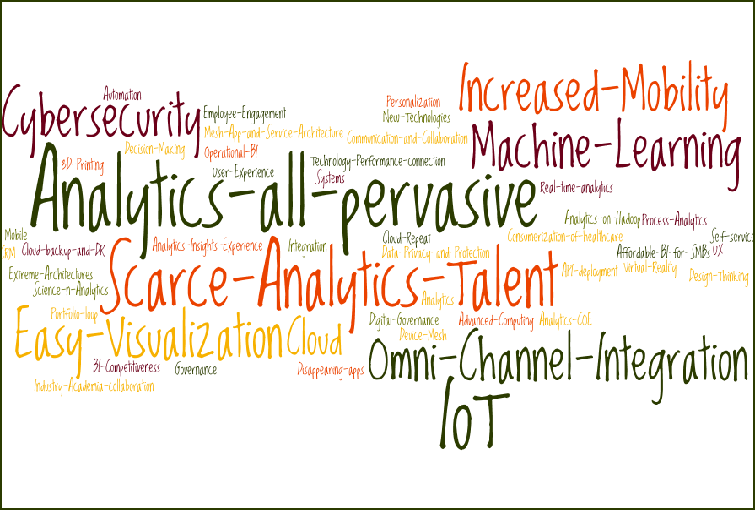Like last year, we bring to you top analytics trends 2016 for SMBs. These trends are based on what industry stalwarts and our clients are saying.
A quick comparison with last year’s trends reveals that some trends continue to evolve. Topics like Deep learning, Self-service-BI, or Cognitive computing are some latest ones being discussed. Nonetheless, others are rapidly gravitating towards some common theme.
One such theme is ‘Big Data Analytics’. More and more small and medium-sized businesses (SMBs in short) are going digital. They are embracing analytics and leveraging their data to turn insights into higher revenues, reduced costs, and overall business growth. According to analysts, the big data analytics market is expected to reach nearly $50B by 2019.
Our Trends focus on the applicability of these technologies to small and medium business (SMB) organizations. As we know, technology plays a vital role in running a business successfully. Yet, some of these emerging technologies are not immediately relevant to SMBs. While it can be helpful to develop an awareness of these technologies, very few SMBs are actually going to use them. For example, the uses of 3D printing or AI in 2016.
This year, we have identified nine top analytics trends that are most relevant to SMBs.
1. More SMBs use analytics for business benefits.
Until a few years back, big data (analytics) was more hype than reality. Google was awash with searches involving keywords centered on ‘Big Data’. However, over the last couple of years, analytics has left the hype curve to provide real value. Today, analytics is everywhere.
Earlier, SMBs were not too savvy about maintaining the data of their customers, product orders, and suppliers. This was largely because of the costs involved in the data storage without the apparent benefit of maintaining the data. However, with the data explosion through various media over the last couple of years and with the availability of custom-analytics providers, they woke to the possibility of utilizing their data for getting answers to some key questions around their businesses. As the benefits started becoming visible – in terms of exponential business growth in a few cases – SMBs started focusing on analytics and become more data-driven to improve their business results.
However, making this data meaningful and easy to understand is still a challenge for many. We think that 2016 will be the year that small-scale analytics will really take off for SMBs, as it allows them to leverage their data from disparate data sources for their business benefits.
2. Internet of Things (IoT) enters our daily lives.
This is what Nikola Tesla said in a 1926 interview with Colliers magazine:

“When wireless is perfectly applied the whole earth will be converted into a huge brain, which in fact it is, all things being particles of a real and rhythmic whole… and the instruments through which we shall be able to do this will be amazingly simple compared with our present telephone. A man will be able to carry one in his vest pocket.“
How it has become a reality less than a century later!
The Internet of Things (IoT) in its current form proliferated with the surge in low cost sensors embedded with Bluetooth wireless capability onto a small chip. And it is rapidly evolving from the realm of fascinating gizmos to real-world utility gadgets. Many leading companies such as Google, Amazon, Cisco, Dell, and TI have developed their versions of IoT products. There are already some cool IoT devices like Nest, Fitbit, and Belkin, to name just a few, that are vying for consumers’ attention in the market.
So what’s in it for SMBs?
In terms of Google trends shown in Exhibit-A, IoT today is where big data analytics was around 4-years back. Gartner forecasts that there will be 6.4 billion internet-connected things in 2016. Although the potential of IoT is huge, few SMBs consider it their ‘critical’ priority for investment at the moment. For them, it is still a nice buzzword. There is still time before every visible thing will have a sensor attached to it that will communicate with your servers in real-time. Meanwhile, SMBs are willing to watch and ride the hype-cycle.

3. Predictive analytics to address cybersecurity concerns.
As SMBs expand their technology footprint to run their business operations, the need to secure and protect data grows. Data security and privacy concerns continue to exist among small and large business organizations. However, many SMBs feel challenged and intimidated to deal with the rising complexity of cybersecurity breaches. Companies are normally content with the conventional approach of putting defensive mechanisms to ward off security risks. However, with technology advancements, the security breaches have also become more sophisticated and more risky wherever consumer data is involved.
While large organizations invest heavily into advanced (read: expensive) security mechanisms, SMBs do not have the luxury to do so. Nevertheless, they are now custom-developing predictive analytic models to proactively monitor log files and other user data sources to detect any threat perception or breach alerts. Clustering algorithms can help them identify anomalies in user login or other events which can be recorded on an ongoing basis. 2016 is likely to see an increase in the application of predictive analytics to deal with cybersecurity concerns.
4. Machine Learning algorithms foster man-machine collaboration.
We are entering the ‘smart’ era – smart people working alongside smart machines in smart cities. IDC¹ predicts that companies will spend more than $60 billion on cognitive solutions by 2025. Theoretically, machine learning algorithms based on neural network and AI have existed for a long time. However, their widespread application in everyday life is getting acceptance only now. This is made possible due to the tremendous increase in processing power that enables real-time split-second decision making.
Machine learning algorithms are currently being employed primarily in retail industry. With more people shopping across multiple channels looking for lowest prices, machine learning algorithms will become very popular in implementing dynamic pricing and devising on-the-spot offers in retail stores to retain the buyer.
For example, during this year’s holiday shopping season, leading retailers such as Amazon and Walmart were relying heavily on algorithmic pricing. Both retailers re-priced 15% of 18,000 product SKUs being tracked by a pricing intelligence solution on November 14th alone. These algorithms will be the backbone of any and every e-commerce business striving to win and retain customers.
[Example credit: Forbes]
5. Rising smartphone and tablet penetration continues to increase consumer mobility.
According to a comScore – Morgan Stanley research, mobile users globally have surpassed desktop users at the beginning of 2014. Rising mobile adoption, among people of all ages, impacts consumer purchasing patterns in a big way. With the increasing mobility, SMBs view mobile apps as a way to reach and engage end-users. SMB Group’s 2014 SMB Mobile Solutions Study indicates 59% of SMBs view mobile solutions and services as ‘critical’ to their business.
6. Hybrid cloud options still complex for SMBs.
2015 saw cloud making deep inroads into data-centers, data warehouses, centralized storages, and servers. SMB group’s market study shows that the cloud is poised to overtake on-premises deployment in the next year in areas such as collaboration, file sharing and marketing automation.
However, SMBs are largely using public cloud and staying away from private (or hybrid) cloud options because of the lack of clarity. Microsoft, Dell, and IBM have their own cloud platforms as hybrid cloud options however they do not yet seem to provide a compelling proposition for SMBs to embrace.
7. Omni-Channel integration or cross-device challenge?
Omni-channel is not a buzzword anymore given the availability of multiple screens every customer has. People have indicated that they love to shop across channels. So, more and more brands are going omni-channel way in a bid to woo consumers and to help them buy in their preferred channels. Brands are applying strategies like location based analytics to make relevant offers when consumers are in the vicinity of their stores. Businesses (like Macy’s or Virgin) that offer a unified omni-channel experience to their customers appear to have a competitive edge over others that cannot.
However, in a March 2015 study by Signal, 51% of marketers worldwide reported that they did not have a single view of customers, and only 6% of marketers worldwide reported they had an adequate single view of customers or prospects across all devices and touchpoints.
From our perspective, this year businesses will make this decision of whether they will play the omni-channel game and how.
8. Real analytics talent is (still) scarce.
According to the 2015 MIT Sloan Management Review survey² of business executives, managers and analytics professionals, 49% of respondents, who believe analytics creates competitive advantage for their organization, say that their company lacks appropriate analytics talent. While there is no dearth of analytics CVs in the market, very few of those appear to have real data science skills. In reality, companies need data scientists who possess the rounded knowledge of computer science, algorithms, math-statistics, business, and analytical skills.
Organizations that hire the less than appropriately skilled analysts end up wasting more than just money without any real benefits accrued. This is the reason more than 50% of analytically challenges organizations have stated that they outsource analytical services to external consultants or organizations, according to the survey.
Smart companies are realizing that analytical talent is critical to their success and in short supply, but more than 40 percent struggle with finding the talent they need. There seems to be a growing belief among SMBs that it is best to focus on customers to grow business leaving the necessary analysis tech work to specialists.
9. Visualization will be vital to SMBs application of analytics.
Data and the insights from that data are no more relegated only to the analysts. Business owners and SMB executives want to visualize their data to understand ‘what’s really going on’ in their business. And they want to do it in minimum possible time to be able to focus on the more important aspect of applying those insights for the improvement of their business. Business analytics in the SMB space is likely to stop being just a set of bar- and pie-based charts, and will be more multi-variate and intuitive. SMBs will demand more from the analysts in terms of visualization techniques that makes it easier and faster to visualize, understand, and explore data and uncover real insights from it.
Conclusion
This is an extremely exciting time for SMBs who can now apply customized analytics as per their specific requirements to take their business to a new level in an economical way. We believe this was not an option they previously had. It will be interesting to see how SMBs embrace business analytics to leverage the opportunity and explore unlimited possibilities.
References:
1 International Data Corporation
2 Ransbotham, D. Kiron and P.K. Prentice, “The Talent Dividend: Analytics talent is driving competitive advantage at data-oriented companies,”MIT Sloan Management Review, April 2015.
3 IoT image credit: wikipedia
<– Most Popular Perspectives from 2015
Analytics in Healthcare: A Veravizion Case Study –>
Top Analytics Trends 2017 – An INFOGRAPHIC –>
You can also subscribe to our blog – Our Perspectives – to receive interesting articles and insights in email. We would love to read your perspectives and comments on that.
Do follow Veravizion on LinkedIn, Twitter, Facebook, or Google+ to receive easy updates.
